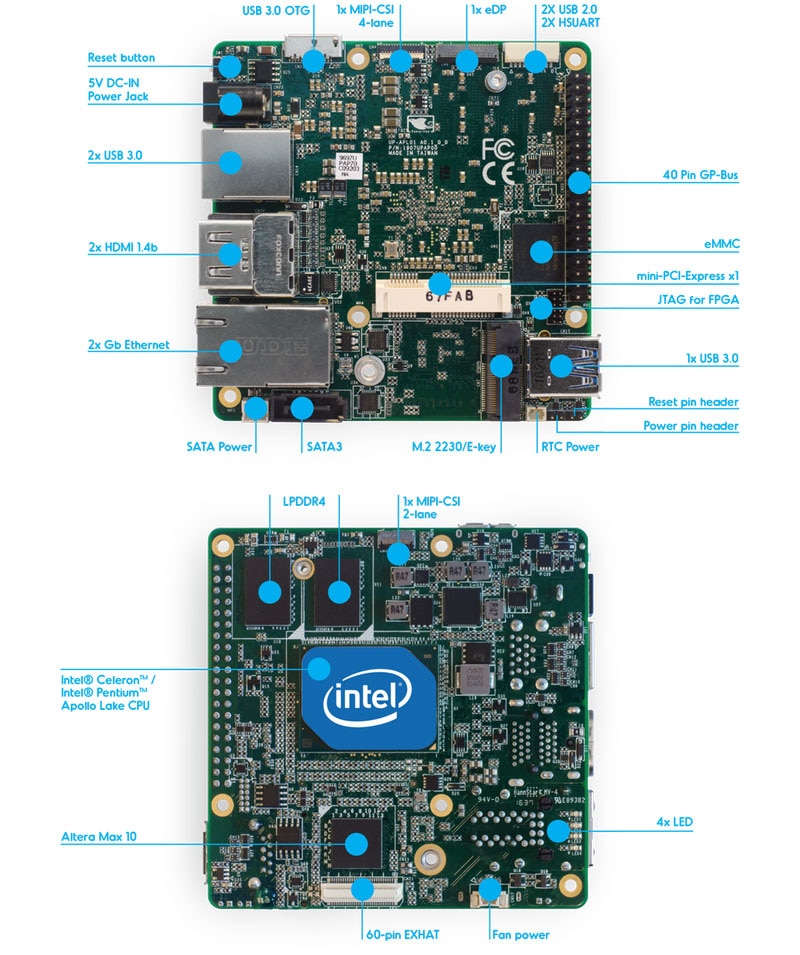UP2 uses the new Intel Apollo Lake™ SoC to integrate into the Industrial Market
2016-11-17 | By Maker.io Staff
The year of the x86 boards, and UP have launched a new KickStarter campaign to bring you the UP Squared (UP²) – an ultra-compact single board computer powered by the latest Intel® Atom™. The board was designed not only for the makers but for the industrial market also. The UP Squared features the latest Intel® Apollo Lake Celeron™ and Pentium™ processors, as well as an on-board Intel® Altera MAX 10 FPGA.
In late 2015, Intel® acquired the acquisition of Altera Corporation. Altera is a leading provider of field programmable gate array technology (FPGA’s). The acquisition was primary to reduce the cost of running the data centres and also excel Intel’s dominance in the IoT market.
Not only does the UP Squared pack powerful hardware but also powerful peripherals such as two HDMI 4k display ports, 2 Gigabit Ethernet ports, four USB 3.0 ports, SATA3 connector for external storage, M.2 slot for additional wireless modules, mini PCIe slot and a 40-pin GPIO header controlled by the Altera FPGA MAX 10.

UP Squared Features on the top side of the board
Powerful GPU
Despite the UP Squared using the powerful Apollo Lake™ SoC, the technology does not stop there. The Intel® Pentium™ N4200 GPU is one of the most powerful GPU’s that Intel has ever designed. The core is the Intel® HD Graphics 505 which runs at base frequency of 200MHz with a graphics burst frequency of 750MHz. The GPU can allocate up to 8GB of RAM and it has 18 Execution Units. It supports Direct X, OpenGL, Intel® Quick Sync Video, Intel® Clear Video HD Technology and up to 3 independent displays.
FPGA
Most conventional single board computers adopt to use a microcontroller such as an ATmega™ or ARM CortexM0+/M4. UP decided to move on with what they consider to be the future (thinking outside the box) and used a FPGA. FPGA’s offer much more flexibility, without changing any hardware on the board you have different electrical characteristics by loading different firmware’s, this is particular in the industrial markets.
By default, the FPGA is programmed to replicate the 40-pin GPIO pinout on the Raspberry Pi™ allowing users access to thousands of add-on boards. The UP team is working hard to create a compatibility list of validated peripherals.
Markets
UP have highlighted a number of the potential markets that the UP Squared board would be developed in:
- Gaming, Media & Entertainment
- Intelligent Vending
- RealSense, Drones & Robotics
- Digital Signage
- Internet of Things
- Home Automation
- Industrial Automation
Although these markets are very valid for the UP Squared board I don’t see it hitting all these markets. However, it does highlight it versatility and outreach. With the very powerful hardware capabilities it would ideally be suited for raw processing of data particular in the Industrial Automation industry.
UP Vs UP2
| UP | UP2 | |
| Dimension | 85.6 x 56.5mm | 85.6 x 90mm |
| CPU | x5-z8300 Quad Core 1.92GHz | Intel® Celeron Dual Core N3350 2.4GHz; Intel® Pentium Quad Core N4200 2.5GHz |
| Memory Type | DDR3L | LPDDR4 |
| Memory Capacity | 4GB | 8GB |
| On-board Storage | 64GB | 128GB |
| USB 2.0 | 6 | 2 |
| USB3.0 | 1 | 4 |
| Expansion | 40-pin GP-bus | 40-pin GP-bus, mini-PCIe, M.2, 60-pin EXHAT |
| SATA3 | N/A | 1 |
| HDMI | 1 | 2 |
| Gigabit Ethernet | 1 | 2 |
| MIPI-CSI | 1x 2-lane | 1x 2-lane + 1x 4-lane |
| Graphics | Intel® Gen 8 HD400 | Intel® Gen 9 HD 500/HD 505 |
| OS Support | Windows 10, Ubuntu, Ubilinux, Yocto, Android M | Windows 10, Ubuntu, Ubilinux, Yocto, Android M |
| Displays Supported | 2 | 3 |
| CPLD/FPGA | Altera Max 5 | Altera Max 10 |
Summary
The UP Squared is going to be a real contender for the maker/industrial market, helping to bridge the gap between maker to market. The board is almost future proof with using the latest hardware from Intel whilst making significant power savings overall at 6W. The KickStarter campaign still has a way to go and has already reached over 100,000 euros with over 500 backers.

Have questions or comments? Continue the conversation on TechForum, DigiKey's online community and technical resource.
Visit TechForum






 中国
中国